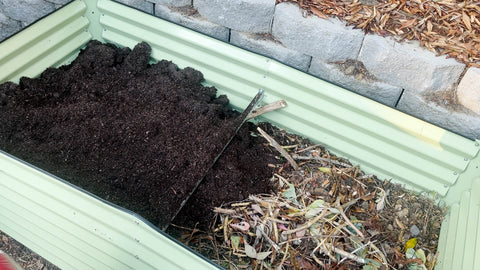The question of how to adequately fill your newly installed raised beds may arise, considering the amount of material needed due to their size or shape. Pondering over whether to use soil or compost, or even the inclusion of twigs, branches, or foliage from your yard?
The most significant inquiry is: what constitutes the foundation of raised garden beds to economize and yet produce optimal outcomes?
The ideal constituents for the base of raised garden beds are those that enrich the soil with carbon and nitrogen as they break down. This includes cardboard, branches, logs, leaves, manure, pine needles, wood chips, and other components like coffee grounds, grass clippings, kitchen waste, and used potting soil.

1. Banana Peels
Banana peels, being rich in calcium, magnesium, phosphorus, and potassium, are a perfect addition to your raised garden beds.
2. Branches
Larger branches should be placed at the bottom of your raised beds, providing valuable space and breaking down relatively swiftly.
3. Cardboard
Thick layers of cardboard make excellent material for the base of your raised beds. Exposing some cardboard around the edges of the bed can also contribute to native grass extermination.
4. Compost
Generously introduce compost, especially the not fully decomposed ones, to the base of your raised beds. Larger compostable items that need a longer decomposition period should go at the bottom. Smaller, finer compost can be layered on top to facilitate decomposition.
5. Eggshells
Eggshells, once rinsed to remove remaining egg yolk and whites, are a valuable addition to any raised bed foundation.
6. Fish Scraps
Remnants from your recent fishing trip or store-bought fish are a great addition to the base of your raised beds, breaking down into a rich organic fertilizer for your plants.

7. Coffee Grounds
Avoid adding used coffee grounds directly to an existing raised bed, but feel free to incorporate them at the base of a new one. They will compost beautifully over time.
8. Flowers
Wilting flowers from your home can also go to the bottom of your raised bed, providing extra nitrogen to your soil as they break down within a month or two.
9. Grass Clippings
Grass clippings make a great addition, provided your yard hasn't been treated for weeds or pests, and the grass isn't seeding. Additionally, steer clear of Bermuda grass due to its intrusive growth nature.
10. Kitchen Scraps
Any compostable kitchen waste is more than welcome at the base of your raised beds, breaking down rapidly and enriching the soil.
11. Leaves
Don’t discard leaves shed by your trees; they can be a great addition to your raised bed foundation, compacting easily and decomposing quickly.
12. Livestock Manure
Manure from farm animals like chicken, cow, goat, horse, llama, and sheep is an excellent addition to the bottom layers of your raised beds. However, ensure a balanced layering of materials and avoid overloading with manure.
13. Logs
For deep raised beds, logs are ideal, filling up space and breaking down over time.
14. Mulch
As long as it's not dyed, mulch is a great addition to the bottom of raised beds, decomposing over time to form good gardening soil.

15. Newsprint
You can incorporate black-and-white newsprint into your raised bed foundation as it breaks down quickly, but avoid using colored ones due to potential harmful dyes.
16. Pine Needles
Just like leaves, pine needles are great additions to the bed bottoms and will break down within 6-8 months.
17. Potting Soil
While new potting soil at the bed bottom would be wasteful, used potting soil from old pots or containers can enhance the decomposition process and create a conducive environment for earthworms.
18. Wood Chips
These small, nicely chopped pieces decompose rapidly and can also serve as excellent mulch for your raised beds after filling them with other materials.









